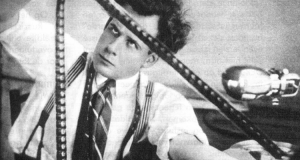3 Unit 3: Soviet Cinema, and The Dominance and Influence of Hollywood on Other National Cinemas
Part 1: Soviet Cinema
Please note, that when we discuss Soviet/Russian Cinema we are talking about the Union of Soviet Socialist Republics from 1922-1991. This area included many now sovereign countries such as Ukraine, Latvia, Georgia and Armenia to name a few. If a filmmaker was working during this time they were doing so with the permission of the Soviet Government which makes their work Russian/Soviet.
No discussion of the history cinema is complete without the contributions of the early Soviet filmmakers. One of the things that makes Soviet cinema so unique is the challenges faced by these filmmakers. Lacking an abundance of film stock to make original films, the Soviets took prints of films and cut them up to edit them into new stories, which leads to the Soviet filmmaking technique popularized by Sergei Eisenstein, dialectical montage.

The Kuleshov Effect
The Kuleshov Effect is a filmmaking technique demonstrated by Soviet filmmaker and theorist Lev Kuleshov. In a nutshell, Kuleshov said that A plus B equals C. He demonstrated that an actor using a single expression could convey different meanings to an audience. In the demonstration we see the man, then we see a bowl of soup and then we see the man again. The audience believes we see a man hungrily eyeing a bowl of soup. Next we see the man, then we see a girl in a coffin and then we see the man again. The audience believes he is looking forlorn on the body of the girl, but in reality the shot of the man each time is the same shot. The audience is interpreting the images and giving them their own meaning.
Here is a video demonstrating The Kuleshov Effect
Yelizaveta Svilova and Dziga Vertov
Yelizaveta Svilova and Dziga Vertov were a husband and wife team who along with many others made what are often referred to as “educational newsreels”, today we might call these propaganda films. Propaganda is intentionally biased media used to promote a political or religious ideology. Vladimir Lenin believed that film could be used to promote the ideals of communism throughout his mostly illiterate nation. In the days of the Soviet Revolution, if you wanted to be a filmmaker, you had to work for the government. Vertov’s most famous film is Man with a Movie Camera(1929). In this film, he displays every possible camera movement and editing technique that could be used. He makes use of montage to the show the life of Russian and Ukrainian citizens. The film presents the Soviet Union as a modern country with modern technology and it also shows off the vast farmlands used to feed the people. Man with a Movie Camera served as inspiration for modern action films and early music videos back when MTV played such things. While Dziga was the director, it was his wife Yelizaveta who was responsible for editing the film. Yelizaveta is one in a long list of female filmmakers who often went uncredited and unnoticed in the first 40 years of filmmaking. In fact, the vast majority of editors working in Hollywood before the advent of talking pictures were women. Take a peek at Man with a Movie Camera and think about how advanced it is compared to films that you have seen prior to 1929.
Man with a Movie Camera
Sergei Eisenstein
Perhaps the most widely known and heralded of the Soviet filmmakers was Sergei Eisenstein. Eisenstein is most famous for his 1925 film The Battleship Potemkin. The film portrays a mutiny on a Russian ship and a protest that was brutally put down by the Cossacks. The Cossacks had declared war on the Bolsheviks led by Vladimir Lenin and The Battleship Potemkin was part of the propaganda that was used to continuously sew hatred towards this group by the Communist Government. Eisenstein took montage to a new level not seen outside of the Soviet Union. While Kuleshov believed you could show two images to infer meaning, Eisenstein believed that montage was more powerful. In his article Beyond the Shot Eisenstein says “The shot is by no means a montage element. The shot is a montage cell. Beyond the dialectical jump in the single series; shot-montage. What then characterises montage and, consequently, its embryo, the shot? Collision. Conflict between two neighboring fragments. Conflict. Collison.” What does this mean? He is telling you that it’s not two shots coming together that make the montage, it is the conflict and collision of these two shots that give the image meaning. His style of filmmaking has a heavy influence on modern action films and has inspired many a homage; including Brian DePalma’s famous train station scene in The Untouchables. Watch the two for comparison.
Odessa Steps scene from The Battleship Potemkin
The train station staircase scene from The Untouchables
Traditionally United States study of Russian cinema stops with the folks mentioned above. Hollywood filmmakers assisted the Russians with propaganda during World War Two. Many of those same filmmakers were later blacklisted by Hollywood. At the end of World War Two, the Russians were no longer our allies and we cut off cultural ties with the country. Very few Russian films were seen outside of the Soviet Union and Russia relied heavily on the output of films from other countries such as India. A favorite amongst Russian immigrants to the United States is The Irony of Fate. The film takes place on New Year’s Eve and it is common to watch the film on December 31st each year. The film makes light of the idea that all Soviet era buildings, cars, trains etc..look the same and a drunken Russian ends up in the wrong apartment, in the wrong city. This is a great film to familiarize yourself with some Soviet era culture, especially if you have Soviet immigrant friends.
Part 2: Dominance and Influence of Hollywood on Other National Cinemas
